Aleut vs Navajo Community Comparison
COMPARE
Aleut
Navajo
Social Comparison
Social Comparison
Aleuts
Navajo
3,609
SOCIAL INDEX
33.6/ 100
SOCIAL RATING
216th/ 347
SOCIAL RANK
1,296
SOCIAL INDEX
10.5/ 100
SOCIAL RATING
316th/ 347
SOCIAL RANK
Navajo Integration in Aleut Communities
The statistical analysis conducted on geographies consisting of 52,382,953 people shows a slight positive correlation between the proportion of Navajo within Aleut communities in the United States with a correlation coefficient (R) of 0.053. On average, for every 1% (one percent) increase in Aleuts within a typical geography, there is an increase of 0.004% in Navajo. To illustrate, in a geography comprising of 100,000 individuals, a rise of 1,000 Aleuts corresponds to an increase of 3.6 Navajo.
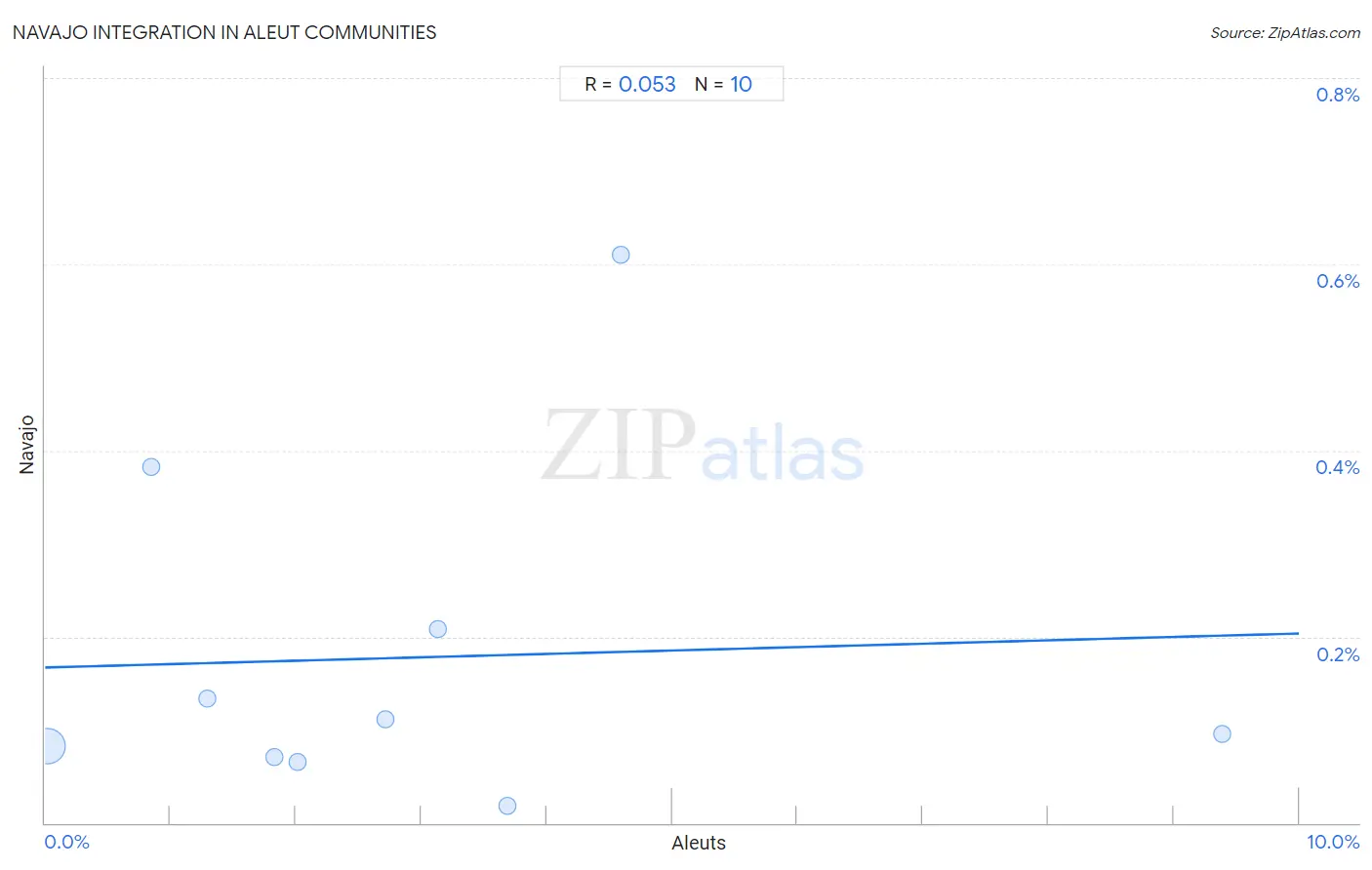
Aleut vs Navajo Income
When considering income, the most significant differences between Aleut and Navajo communities in the United States are seen in per capita income ($42,210 compared to $29,031, a difference of 45.4%), householder income ages 45 - 64 years ($100,052 compared to $69,759, a difference of 43.4%), and median household income ($83,446 compared to $59,159, a difference of 41.0%). Conversely, both communities are more comparable in terms of wage/income gap (23.7% compared to 22.4%, a difference of 6.2%), median female earnings ($38,719 compared to $33,046, a difference of 17.2%), and householder income under 25 years ($50,377 compared to $42,380, a difference of 18.9%).

| Income Metric | Aleut | Navajo |
| Per Capita Income | Poor $42,210 | Tragic $29,031 |
| Median Family Income | Poor $98,702 | Tragic $70,989 |
| Median Household Income | Fair $83,446 | Tragic $59,159 |
| Median Earnings | Tragic $44,241 | Tragic $36,999 |
| Median Male Earnings | Tragic $51,168 | Tragic $42,098 |
| Median Female Earnings | Poor $38,719 | Tragic $33,046 |
| Householder Age | Under 25 years | Tragic $50,377 | Tragic $42,380 |
| Householder Age | 25 - 44 years | Poor $91,370 | Tragic $66,529 |
| Householder Age | 45 - 64 years | Average $100,052 | Tragic $69,759 |
| Householder Age | Over 65 years | Excellent $62,708 | Tragic $47,722 |
| Wage/Income Gap | Exceptional 23.7% | Exceptional 22.4% |
Aleut vs Navajo Poverty
When considering poverty, the most significant differences between Aleut and Navajo communities in the United States are seen in married-couple family poverty (4.7% compared to 11.9%, a difference of 152.6%), family poverty (9.5% compared to 18.8%, a difference of 99.0%), and male poverty (11.8% compared to 22.3%, a difference of 89.4%). Conversely, both communities are more comparable in terms of single mother poverty (32.9% compared to 40.2%, a difference of 22.2%), single female poverty (25.4% compared to 31.7%, a difference of 24.5%), and female poverty among 18-24 year olds (20.9% compared to 30.3%, a difference of 44.8%).
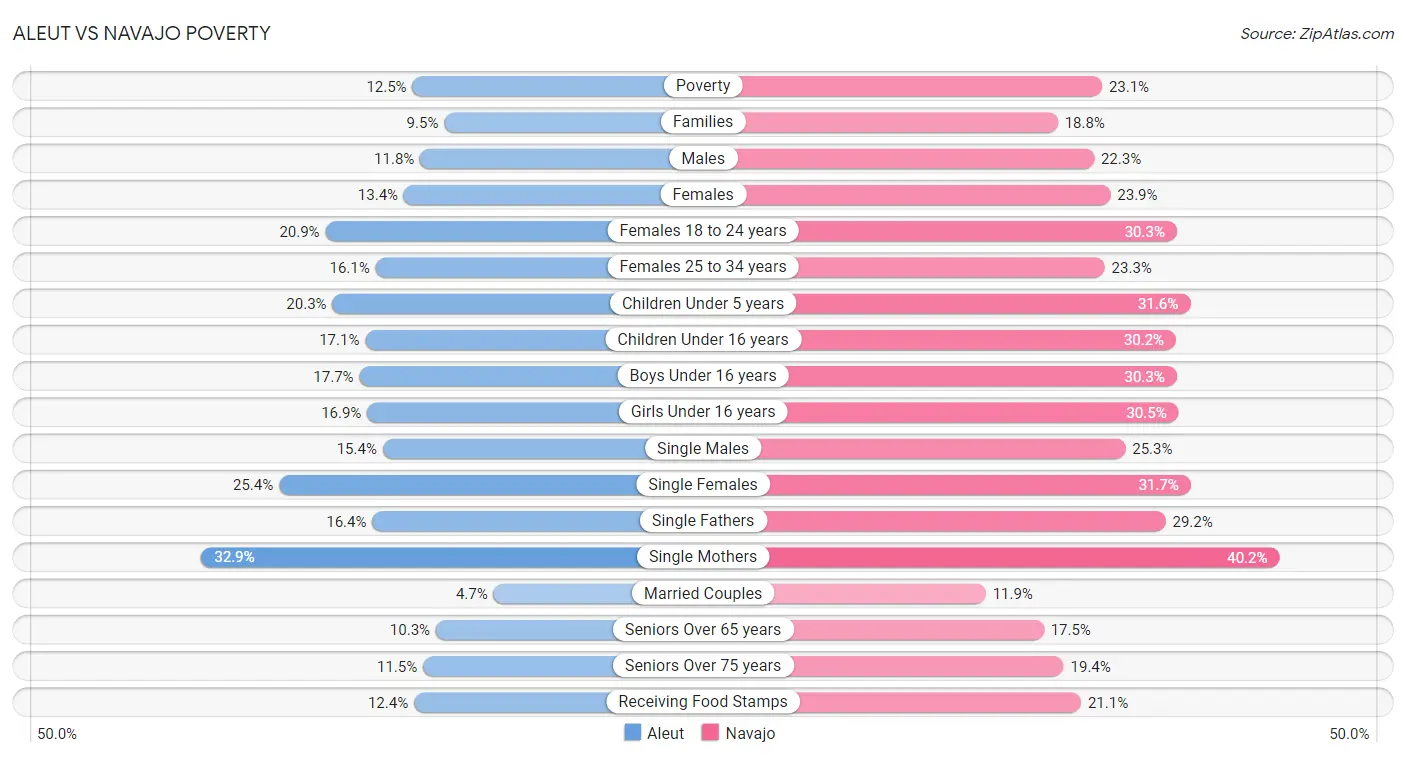
| Poverty Metric | Aleut | Navajo |
| Poverty | Fair 12.5% | Tragic 23.1% |
| Families | Poor 9.5% | Tragic 18.8% |
| Males | Poor 11.8% | Tragic 22.3% |
| Females | Average 13.4% | Tragic 23.9% |
| Females 18 to 24 years | Tragic 20.9% | Tragic 30.3% |
| Females 25 to 34 years | Tragic 16.1% | Tragic 23.3% |
| Children Under 5 years | Tragic 20.3% | Tragic 31.6% |
| Children Under 16 years | Poor 17.1% | Tragic 30.2% |
| Boys Under 16 years | Tragic 17.7% | Tragic 30.3% |
| Girls Under 16 years | Fair 16.9% | Tragic 30.5% |
| Single Males | Tragic 15.4% | Tragic 25.3% |
| Single Females | Tragic 25.4% | Tragic 31.7% |
| Single Fathers | Fair 16.4% | Tragic 29.2% |
| Single Mothers | Tragic 32.9% | Tragic 40.2% |
| Married Couples | Exceptional 4.7% | Tragic 11.9% |
| Seniors Over 65 years | Exceptional 10.3% | Tragic 17.5% |
| Seniors Over 75 years | Exceptional 11.5% | Tragic 19.4% |
| Receiving Food Stamps | Poor 12.4% | Tragic 21.1% |
Aleut vs Navajo Unemployment
When considering unemployment, the most significant differences between Aleut and Navajo communities in the United States are seen in unemployment among women with children under 6 years (7.5% compared to 13.5%, a difference of 79.9%), unemployment among ages 35 to 44 years (5.6% compared to 9.3%, a difference of 67.4%), and unemployment among women with children under 18 years (5.4% compared to 8.2%, a difference of 52.1%). Conversely, both communities are more comparable in terms of unemployment among ages 55 to 59 years (6.4% compared to 6.7%, a difference of 4.4%), unemployment among ages 60 to 64 years (6.8% compared to 6.3%, a difference of 8.1%), and unemployment among seniors over 65 years (6.0% compared to 6.7%, a difference of 12.2%).
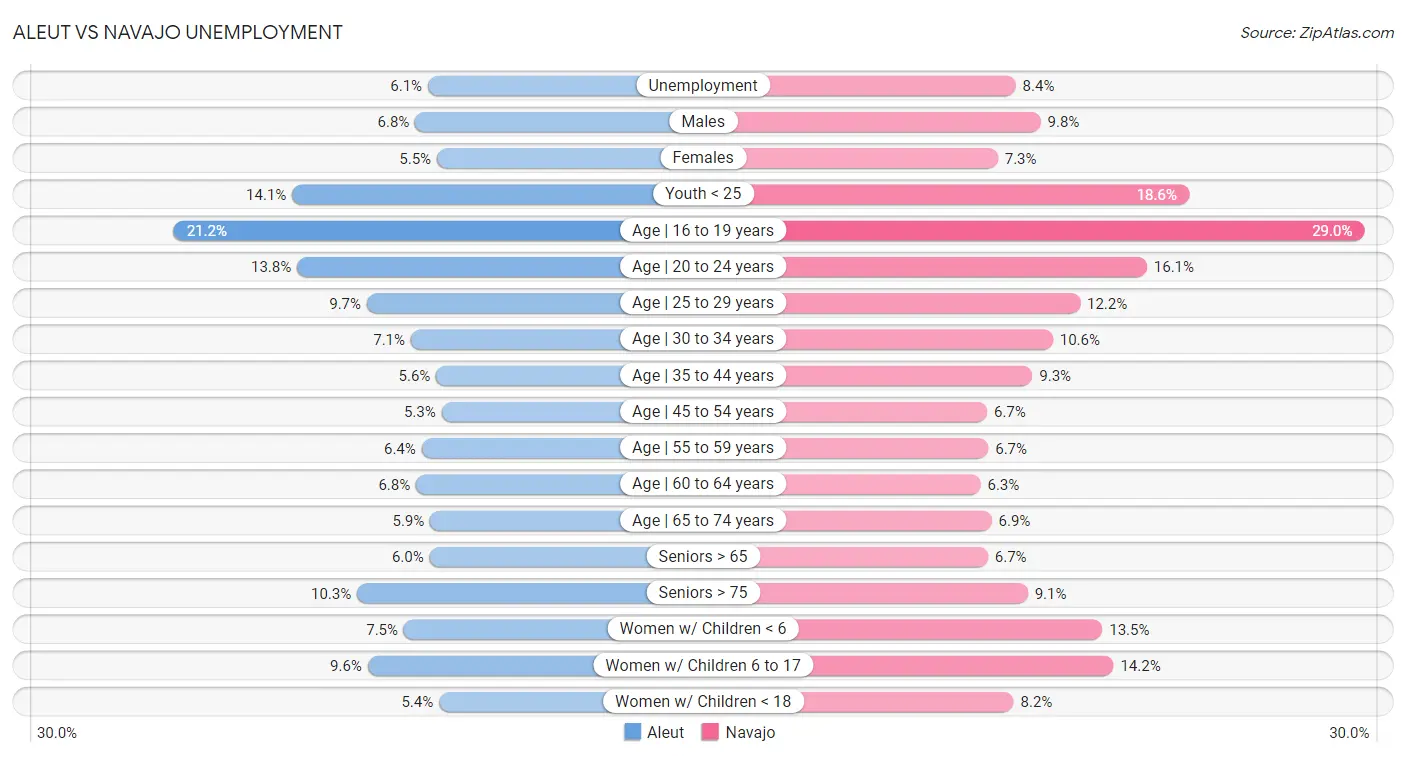
| Unemployment Metric | Aleut | Navajo |
| Unemployment | Tragic 6.1% | Tragic 8.4% |
| Males | Tragic 6.8% | Tragic 9.8% |
| Females | Tragic 5.5% | Tragic 7.3% |
| Youth < 25 | Tragic 14.1% | Tragic 18.6% |
| Age | 16 to 19 years | Tragic 21.2% | Tragic 29.0% |
| Age | 20 to 24 years | Tragic 13.8% | Tragic 16.1% |
| Age | 25 to 29 years | Tragic 9.7% | Tragic 12.2% |
| Age | 30 to 34 years | Tragic 7.1% | Tragic 10.6% |
| Age | 35 to 44 years | Tragic 5.6% | Tragic 9.3% |
| Age | 45 to 54 years | Tragic 5.3% | Tragic 6.7% |
| Age | 55 to 59 years | Tragic 6.4% | Tragic 6.7% |
| Age | 60 to 64 years | Tragic 6.8% | Tragic 6.3% |
| Age | 65 to 74 years | Tragic 5.9% | Tragic 6.9% |
| Seniors > 65 | Tragic 6.0% | Tragic 6.7% |
| Seniors > 75 | Tragic 10.3% | Tragic 9.1% |
| Women w/ Children < 6 | Good 7.5% | Tragic 13.5% |
| Women w/ Children 6 to 17 | Tragic 9.6% | Tragic 14.2% |
| Women w/ Children < 18 | Average 5.4% | Tragic 8.2% |
Aleut vs Navajo Labor Participation
When considering labor participation, the most significant differences between Aleut and Navajo communities in the United States are seen in in labor force | age 16-19 (40.4% compared to 32.1%, a difference of 26.0%), in labor force | age 20-24 (79.0% compared to 64.8%, a difference of 21.8%), and in labor force | age > 16 (66.0% compared to 56.6%, a difference of 16.6%). Conversely, both communities are more comparable in terms of in labor force | age 45-54 (81.0% compared to 72.8%, a difference of 11.2%), in labor force | age 25-29 (83.4% compared to 74.6%, a difference of 11.8%), and in labor force | age 30-34 (82.6% compared to 73.8%, a difference of 12.0%).

| Labor Participation Metric | Aleut | Navajo |
| In Labor Force | Age > 16 | Exceptional 66.0% | Tragic 56.6% |
| In Labor Force | Age 20-64 | Tragic 78.2% | Tragic 69.2% |
| In Labor Force | Age 16-19 | Exceptional 40.4% | Tragic 32.1% |
| In Labor Force | Age 20-24 | Exceptional 79.0% | Tragic 64.8% |
| In Labor Force | Age 25-29 | Tragic 83.4% | Tragic 74.6% |
| In Labor Force | Age 30-34 | Tragic 82.6% | Tragic 73.8% |
| In Labor Force | Age 35-44 | Average 84.4% | Tragic 73.8% |
| In Labor Force | Age 45-54 | Tragic 81.0% | Tragic 72.8% |
Aleut vs Navajo Family Structure
When considering family structure, the most significant differences between Aleut and Navajo communities in the United States are seen in births to unmarried women (39.3% compared to 51.5%, a difference of 30.9%), single mother households (6.8% compared to 8.8%, a difference of 29.5%), and currently married (46.7% compared to 39.0%, a difference of 19.6%). Conversely, both communities are more comparable in terms of family households with children (27.4% compared to 26.9%, a difference of 1.8%), divorced or separated (12.5% compared to 12.0%, a difference of 4.3%), and family households (63.4% compared to 66.4%, a difference of 4.6%).

| Family Structure Metric | Aleut | Navajo |
| Family Households | Tragic 63.4% | Exceptional 66.4% |
| Family Households with Children | Average 27.4% | Tragic 26.9% |
| Married-couple Households | Poor 45.6% | Tragic 40.1% |
| Average Family Size | Average 3.23 | Exceptional 3.65 |
| Single Father Households | Tragic 3.0% | Tragic 3.2% |
| Single Mother Households | Tragic 6.8% | Tragic 8.8% |
| Currently Married | Average 46.7% | Tragic 39.0% |
| Divorced or Separated | Tragic 12.5% | Good 12.0% |
| Births to Unmarried Women | Tragic 39.3% | Tragic 51.5% |
Aleut vs Navajo Vehicle Availability
When considering vehicle availability, the most significant differences between Aleut and Navajo communities in the United States are seen in no vehicles in household (13.0% compared to 9.4%, a difference of 38.2%), 4 or more vehicles in household (6.9% compared to 8.2%, a difference of 19.5%), and 3 or more vehicles in household (20.2% compared to 22.3%, a difference of 10.5%). Conversely, both communities are more comparable in terms of 2 or more vehicles in household (54.1% compared to 55.3%, a difference of 2.3%), 1 or more vehicles in household (87.5% compared to 90.8%, a difference of 3.8%), and 3 or more vehicles in household (20.2% compared to 22.3%, a difference of 10.5%).

| Vehicle Availability Metric | Aleut | Navajo |
| No Vehicles Available | Tragic 13.0% | Exceptional 9.4% |
| 1+ Vehicles Available | Tragic 87.5% | Exceptional 90.8% |
| 2+ Vehicles Available | Tragic 54.1% | Average 55.3% |
| 3+ Vehicles Available | Excellent 20.2% | Exceptional 22.3% |
| 4+ Vehicles Available | Exceptional 6.9% | Exceptional 8.2% |
Aleut vs Navajo Education Level
When considering education level, the most significant differences between Aleut and Navajo communities in the United States are seen in no schooling completed (1.6% compared to 2.1%, a difference of 35.5%), bachelor's degree (31.3% compared to 23.6%, a difference of 32.6%), and professional degree (3.6% compared to 2.9%, a difference of 25.9%). Conversely, both communities are more comparable in terms of nursery school (98.7% compared to 98.0%, a difference of 0.69%), kindergarten (98.6% compared to 98.0%, a difference of 0.69%), and 1st grade (98.6% compared to 97.9%, a difference of 0.69%).
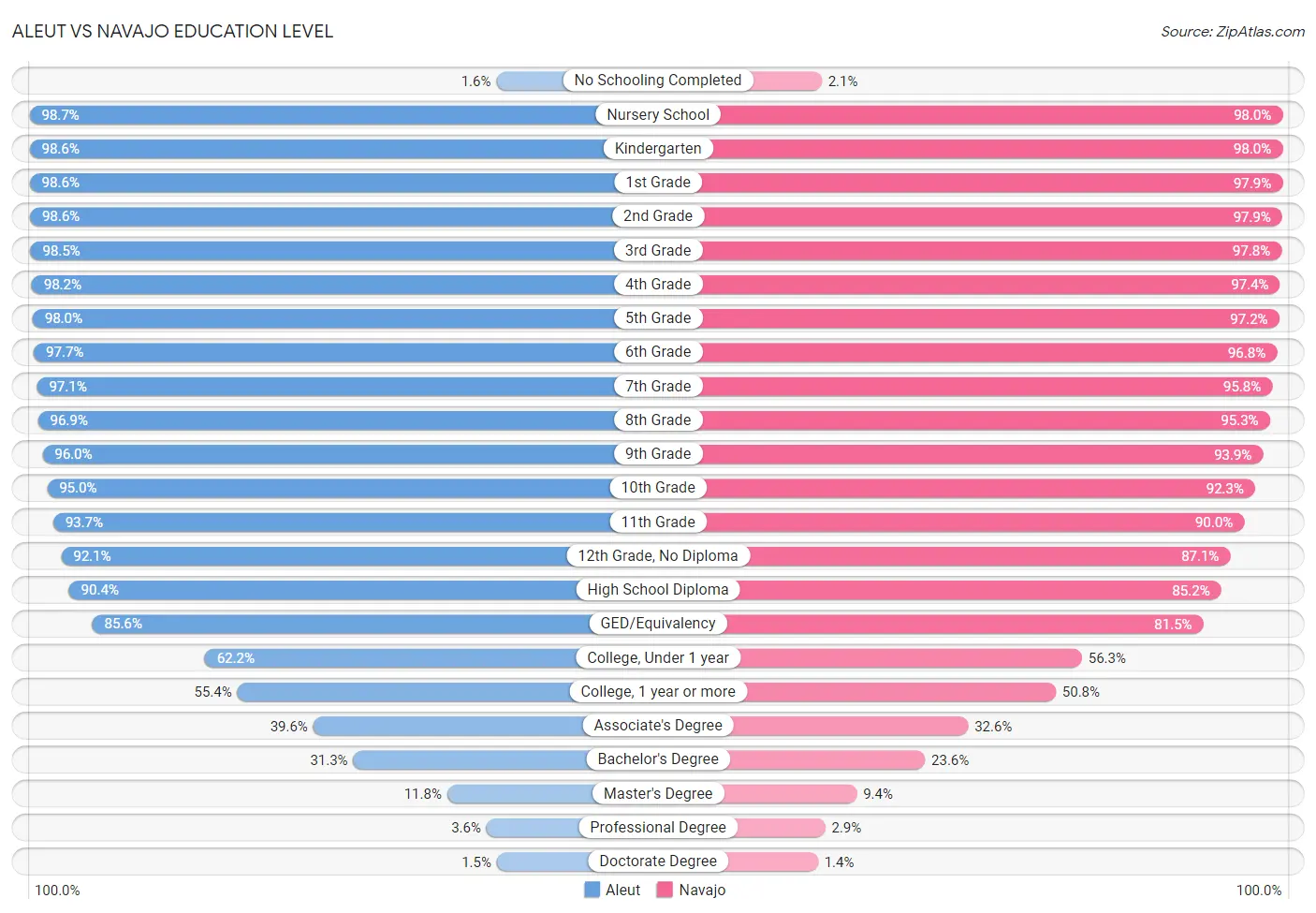
| Education Level Metric | Aleut | Navajo |
| No Schooling Completed | Exceptional 1.6% | Fair 2.1% |
| Nursery School | Exceptional 98.7% | Average 98.0% |
| Kindergarten | Exceptional 98.6% | Average 98.0% |
| 1st Grade | Exceptional 98.6% | Average 97.9% |
| 2nd Grade | Exceptional 98.6% | Average 97.9% |
| 3rd Grade | Exceptional 98.5% | Average 97.8% |
| 4th Grade | Exceptional 98.2% | Fair 97.4% |
| 5th Grade | Exceptional 98.0% | Fair 97.2% |
| 6th Grade | Exceptional 97.7% | Tragic 96.8% |
| 7th Grade | Exceptional 97.1% | Poor 95.8% |
| 8th Grade | Exceptional 96.9% | Tragic 95.3% |
| 9th Grade | Exceptional 96.0% | Tragic 93.9% |
| 10th Grade | Exceptional 95.0% | Tragic 92.3% |
| 11th Grade | Exceptional 93.7% | Tragic 90.0% |
| 12th Grade, No Diploma | Exceptional 92.1% | Tragic 87.1% |
| High School Diploma | Exceptional 90.4% | Tragic 85.2% |
| GED/Equivalency | Average 85.6% | Tragic 81.5% |
| College, Under 1 year | Tragic 62.2% | Tragic 56.3% |
| College, 1 year or more | Tragic 55.4% | Tragic 50.8% |
| Associate's Degree | Tragic 39.6% | Tragic 32.6% |
| Bachelor's Degree | Tragic 31.3% | Tragic 23.6% |
| Master's Degree | Tragic 11.8% | Tragic 9.4% |
| Professional Degree | Tragic 3.6% | Tragic 2.9% |
| Doctorate Degree | Tragic 1.5% | Tragic 1.4% |
Aleut vs Navajo Disability
When considering disability, the most significant differences between Aleut and Navajo communities in the United States are seen in disability age under 5 (1.2% compared to 1.6%, a difference of 40.2%), vision disability (2.6% compared to 3.1%, a difference of 21.7%), and disability age 65 to 74 (28.4% compared to 33.3%, a difference of 17.2%). Conversely, both communities are more comparable in terms of disability age 18 to 34 (8.1% compared to 8.1%, a difference of 0.050%), disability age 5 to 17 (5.3% compared to 5.4%, a difference of 2.0%), and self-care disability (2.8% compared to 2.9%, a difference of 2.1%).
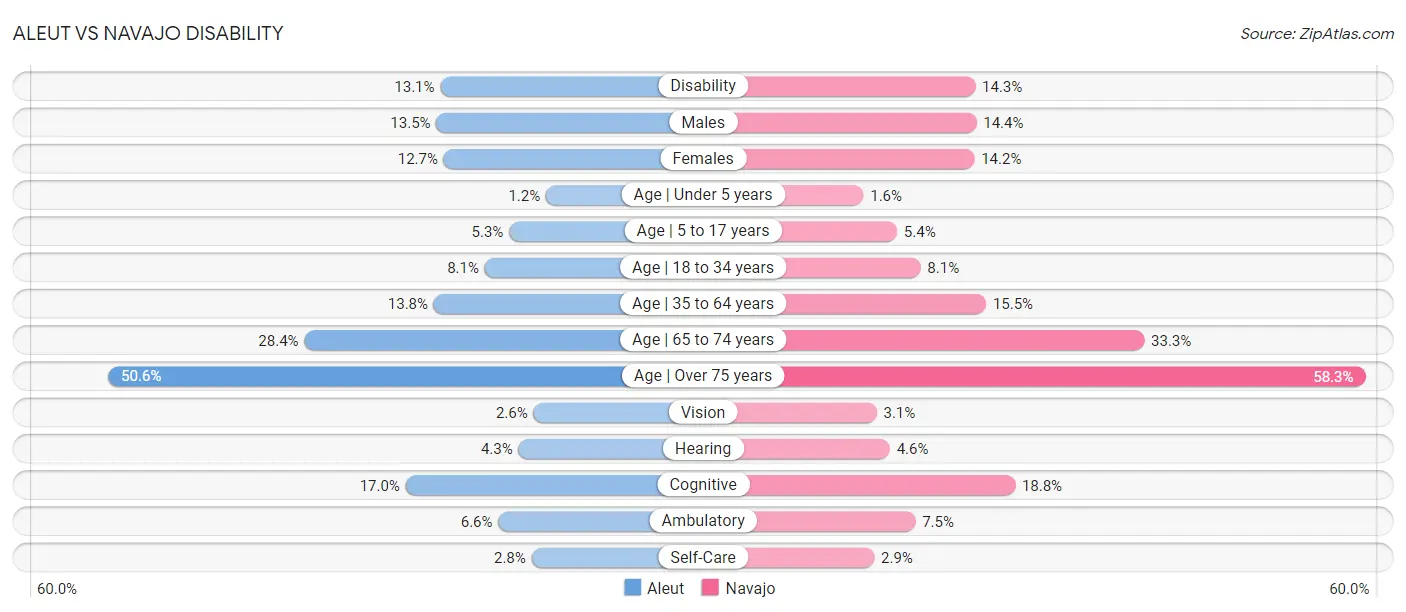
| Disability Metric | Aleut | Navajo |
| Disability | Tragic 13.1% | Tragic 14.3% |
| Males | Tragic 13.5% | Tragic 14.4% |
| Females | Tragic 12.7% | Tragic 14.2% |
| Age | Under 5 years | Exceptional 1.2% | Tragic 1.6% |
| Age | 5 to 17 years | Exceptional 5.3% | Exceptional 5.4% |
| Age | 18 to 34 years | Tragic 8.1% | Tragic 8.1% |
| Age | 35 to 64 years | Tragic 13.8% | Tragic 15.5% |
| Age | 65 to 74 years | Tragic 28.4% | Tragic 33.3% |
| Age | Over 75 years | Tragic 50.6% | Tragic 58.3% |
| Vision | Tragic 2.6% | Tragic 3.1% |
| Hearing | Tragic 4.3% | Tragic 4.6% |
| Cognitive | Excellent 17.0% | Tragic 18.8% |
| Ambulatory | Tragic 6.6% | Tragic 7.5% |
| Self-Care | Tragic 2.8% | Tragic 2.9% |